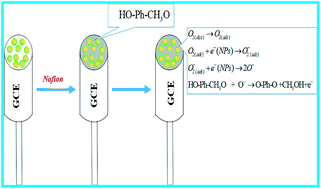Development of an efficient phenolic sensor based on facile Ag2O/Sb2O3 nanoparticles for environmental safety†
Abstract
The facile hydrothermal method was used to prepare low-dimensional doped Ag2O/Sb2O3 nanoparticles (NPs) at low temperature in alkaline medium. The calcined NPs were characterized in detail by FTIR, UV/vis, FESEM, XPS, EDS, and XRD. A thin layer of Ag2O/Sb2O3 NPs was deposited onto a glassy carbon electrode (GCE) using Nafion (5% Nafion suspension in ethanol) conducting binder, which formed the working electrode of the selective 3-methoxyphenol electrochemical sensor probe. The proposed chemical sensor exhibits high sensitivity, long-term stability, and enhanced electrochemical responses towards 3-methoxyphenol. Response to 3-methoxyphenol is linear over the concentration range (LDR) of 0.09 nM to 0.09 mM. The analytical parameters of the sensor such as sensitivity, stability, response time, linearity, LDR, robustness, selectivity etc. were evaluated by an electrochemical approach. The sensor probe fabricated with Ag2O/Sb2O3 NPs seems to be a promising candidate for effective and reliable electrochemical detection of hazardous and carcinogenic chemicals in the environment and health care fields in large scales.



 Please wait while we load your content...
Please wait while we load your content...